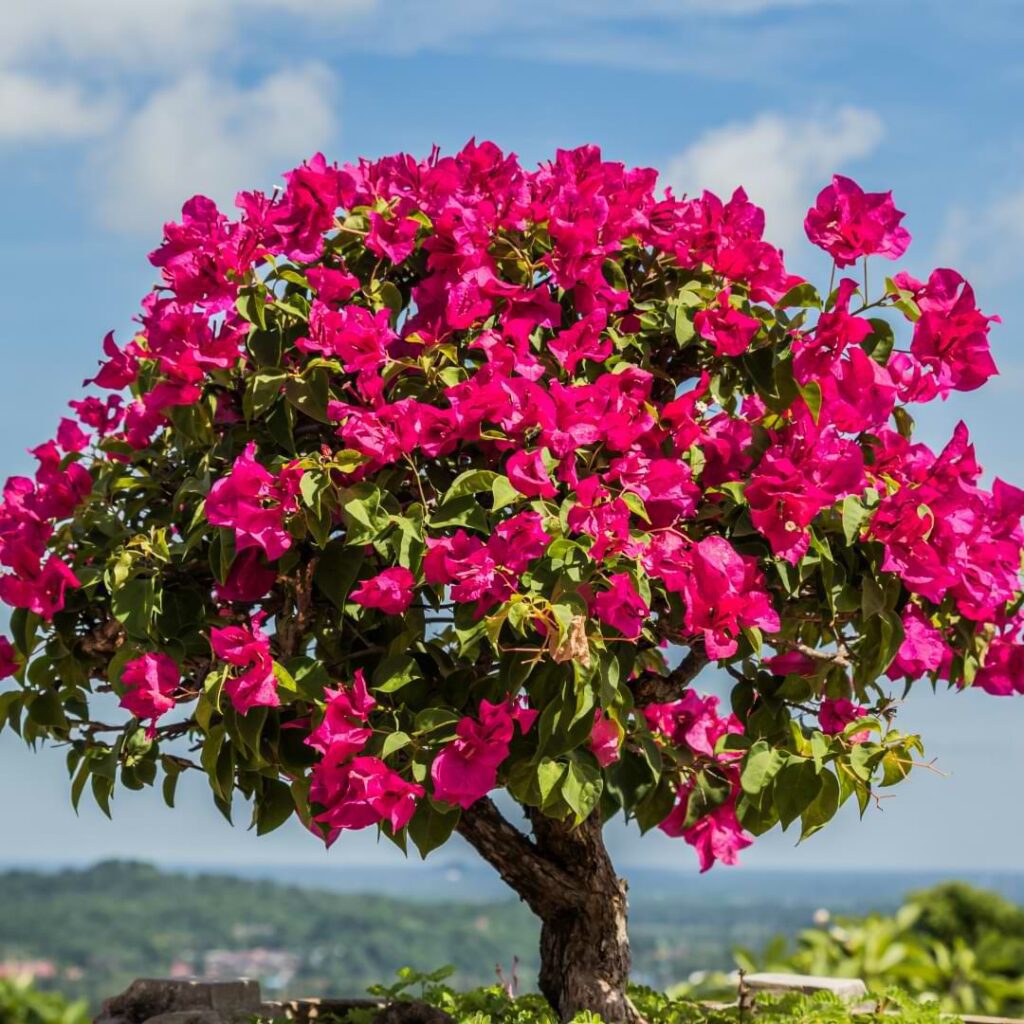When it comes to expressing creativity and cultivating beauty, purple and pink bonsai trees are a bonsai lover’s “Starry Night.” Not only do they add vibrant colors to your garden or home, but they also symbolize peace and balance.
This post will tell you all you need to know about these majestic bonsai trees. We’ll share images of stunning purple and pink bonsai trees, as well as tips for how to care for them. So if you’ve been thinking about adding a splash of color to your home, read on!
Are Pink Bonsai Trees Real
Yes, pink bonsai trees are real! These beautiful trees are either a naturally pink variety of flowering tree, or they can be created by grafting two different species of tree together. The grafting method is truly unique, as the top part of the tree is a pink flowering variety, while the bottom part is a green leafy variety, creating a two-toned effect that is truly breathtaking.
13 Purple And Pink Bonsai Trees List And Identification
Purple and pink bonsai trees are a beautiful and unique addition to any bonsai collection, and finding the right one for your home is easy! Here is a list of our favorite purple and pink bonsai trees, along with some tips on how to identify them, and any special care requirements they might have.
1) Bougainvillea Bonsai
Bougainvillea bonsai is a type of bonsai tree that is grown from a cutting of a Bougainvillea plant. The tree is native to Brazil and gets its name from the Brazilian city of Bougainvillea. The bonsai tree was introduced to Japan in the early 20th century and has been popularized in recent years.
The bougainvillea bonsai tree is a beautiful and unique plant that makes a great addition to any home or garden. The tree produces colorful flowers that range in shade from pink to purple. The leaves of the tree are small and oval-shaped, and the branches are thin and delicate. The tree can be trained to grow in many different shapes, making it a versatile plant for bonsai enthusiasts.
This tree likes higher temperatures during the growing season, but lower temperatures in the fall and winter. It can be placed outside to get full sun in spring and summer, but can not ensure temperatures below 50 degrees Fahrenheit. In the fall and winter, keep this tree in a shed or garage with temperatures ranging from 50 degrees to 60 degrees Fahrenheit.
2) Chinese Fringe Bonsai
Chinese fringe bonsai are created using the same techniques as other bonsai, but they feature leaves that are uniquely fringed. The flowers on this tree are almost a dark neon pink, making it a stunning statement piece.
This tree would be happiest in a garden anywhere that it does not get below freezing, but it can certainly live inside if you live somewhere with colder winters. This tree loves to have plenty of sunlight, as long as it’s not too harsh and is semi-shaded with the stronger afternoon sun.
3) Double Bloomed Cherry
Double bloomed cherry trees are some of the most beautiful and interesting bonsai trees. The Shirofugen cherry tree is a tree that produces a set of bright pink buds that burst into double-bloomed flowers in the spring. These flowers are initially a white or light pink with a bright pink middle, and as the flower matures, the pink deepens and consumes the entire flower.
To promote as many blooms as possible, the Shirofugen tree can withstand fertilizing every two weeks during the growing season. This tree loves to live outdoors in mild temperatures, but is slightly more cold-hardy than other pink bonsai tree varieties.
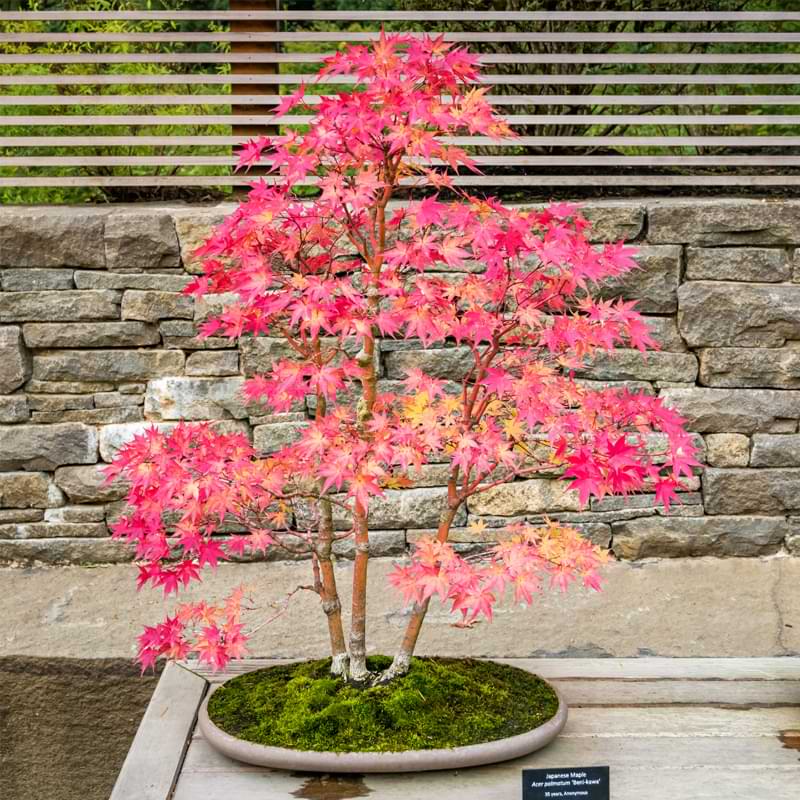
4) Japanese Maple Bonsai
Japanese Maples are the perfect pink bonsai tree. Their small leaves and delicate branches make them one of the most popular bonsai trees today but their pink flowers make them one of the most beautiful. This tree is native to Japan, Korea, and China.
Japanese Maples can be trained in many different styles, but the most popular are informal upright, formal upright, cascade, and broom styles. Make sure to keep your Japanese Maple in a high quality bonsai potting mix that is well-draining, because this tree does not like having its roots too wet for too long.
The Japanese Maple prefers a sunny spot with temperatures up to 85 degrees Fahrenheit. If temperatures go above 85, move your bonsai tree to a shadier spot. If it goes much over 85 degrees, consider moving this tree inside until temperatures drop again. It can also be grown only indoors, as long as the inside temperature is not too cold, and you provide the tree with plenty of natural light.
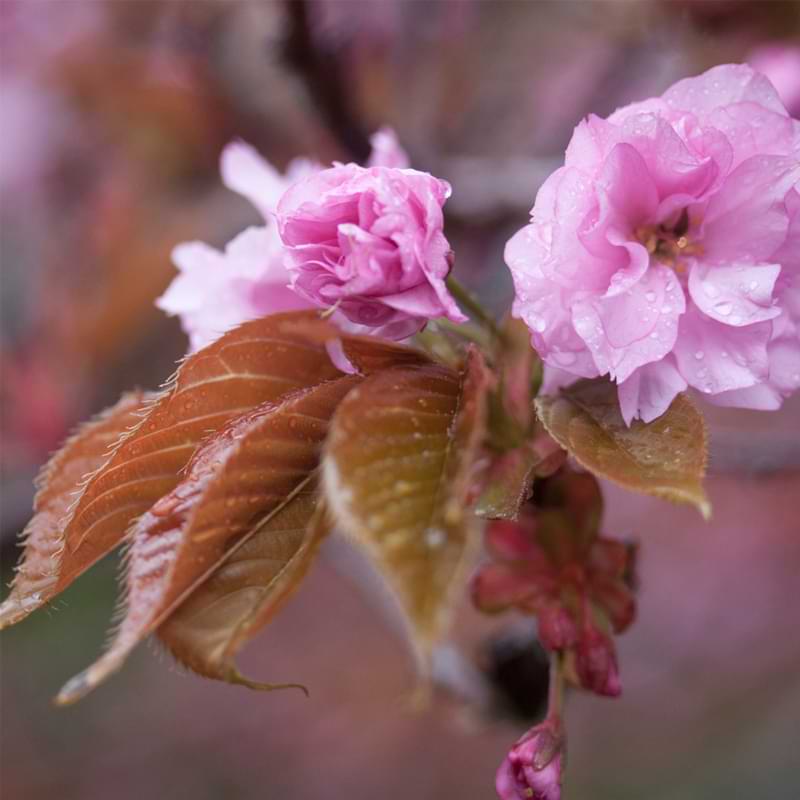
5) Kwanzan Cherry bonsai
Kwanzan cherry bonsai trees are prized for their beautiful pink and white flowers which bloom in early spring. They are relatively easy to care for, making them a popular choice for beginners. Their flowers are beautiful, with a very full, almost rose-like appearance, and usually a light to medium pink color.
They prefer full sun, with temperatures staying below 90 degrees Fahrenheit in the spring and summer, and much lower temperatures in the fall and winter, between 0-64 degrees Fahrenheit. They require well-drained soil, and should be watered and fertilized regularly during the growing season.
6) Okame Cherry Bonsai
Okame cherry bonsai trees are simply stunning. The vibrant but soft pink blooms contrast beautifully against the bark of the tree. These trees are relatively easy to care for, making them ideal for beginners. They require moderate temperatures, and regular watering, fertilizing, and pruning.
As a bonsai tree, the Okame may need a bit of root pruning to ensure the tree doesn’t get out of control, and you will want to shape this tree soon after growth appears. It tends to harden a bit faster than other young bonsai trees.
7) Pink Azalea Bonsaiv
Azaleas are a popular choice for bonsai, and pink azaleas are especially lovely. There are many different varieties of pink azalea, so you can choose one that suits your taste and style.
Pink azaleas are known for their beautiful flowers, which bloom in shades of pink from light to dark. The flowers are delicate and often have a sweet fragrance. Pink azalea bonsai trees are one of the easiest to care for, and will give you plenty of gorgeous blooms to enjoy.
This tree doesn’t require any special care, just the general upkeep of a bonsai tree. The only difference with this tree is that the blooms are rather delicate, so when flowering, keep it out of high wind or rainy weather. It also should be protected from temperatures below 40 degrees Fahrenheit, and above 90 degrees Fahrenheit.
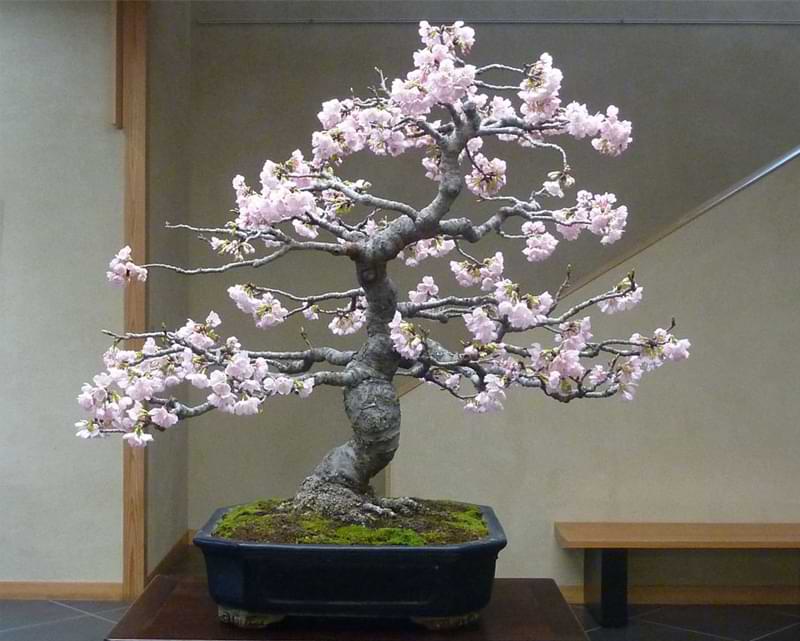
8) Pink Sakura Bonsai
Pink sakura bonsai trees are a beautiful variety of bonsai that is perfect for adding a splash of color to your home. They are native to Japan and China and have been cultivated for centuries.
The pink sakura bonsai tree is a deciduous tree, meaning it will lose its leaves in the winter months. It typically blooms in the springtime, around April or May. The flowers on the tree are delicate and have a beautiful light pink color.
This type of bonsai is best suited for growing in cooler to mild climates. If you live in a warm climate, you will need to take steps to protect your tree from the heat. One way to do this is to grow your tree in a pot that has good drainage and place it in an area that does not receive direct sunlight. That being said, this tree does need six or more hours of sunlight that is not too harsh every day for it to thrive.
Pink sakura bonsai trees are a bit of a more difficult tree to care for, but as long as they are watered regularly and kept within the right temperature range, they should live for quite some time.
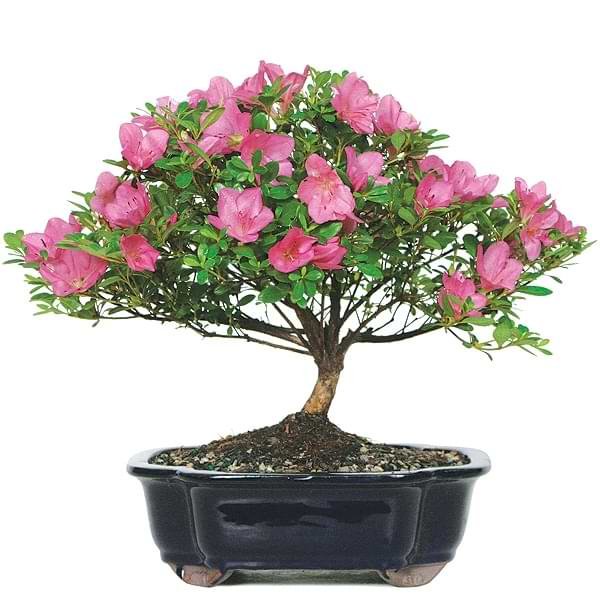
9) Satsuki Azalea
The Satsuki Azalea is a species of azalea that is native to Japan. It is named after the fifth month in the old lunar calendar, when the azaleas are typically in bloom. The Satsuki Azalea is an evergreen shrub that can grow to be about 6 feet tall and 8 feet wide when grown outside, but can easily be grown as a bonsai.
This tree will do best when kept outside in temperatures between 60 and 90 degrees Fahrenheit, and then brought inside when temperatures drop below 45 degrees. Once the tree goes dormant for the season, it can be kept between 45 and 50 degrees to allow the tree to rest for the whole dormant season.
Other than the dormancy period, this tree is fairly easy to care for, simply water it on a regular schedule when the soil dries out, fertilize it every few weeks during the growing season, and prune as needed to shape the tree to your liking.
10) Weeping Cherry Bonsai
The weeping cherry bonsai is a beautiful and delicate tree that is perfect for those who love pink and purple hues. This tree is known for its graceful drooping branches and stunning blooms. Weeping cherry bonsai trees are extremely unique, and care should be taken when pruning this tree.
Care and maintenance of the tree is just as a normal bonsai cherry tree would be, and as long as you are keeping the tree on a decent watering and fertilizing schedule, it should continue to thrive.
When pruning and shaping this tree, be careful of the trunk and the delicate weeping branches. Don’t cut too much, and when in doubt, let the tree rest before making any more cuttings.
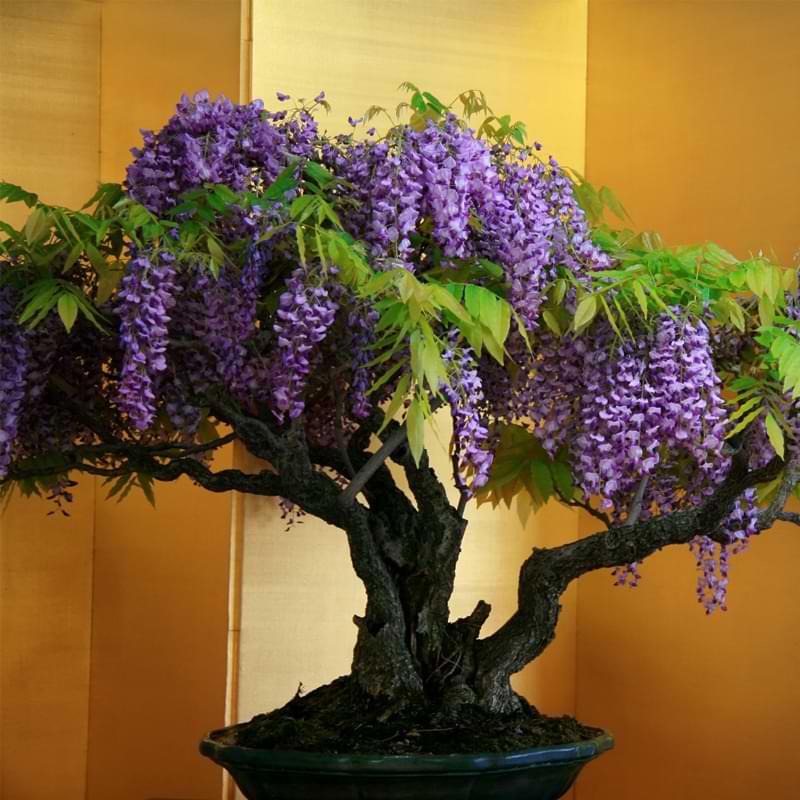
11) Wisteria Bonsai
Wisteria bonsai are some of the most stunning trees you will ever see. They are incredibly rare, and their beauty is simply breathtaking. The flowers of a wisteria bonsai tree are a deep purple, and they have a sweet fragrance that is absolutely intoxicating.
These trees are native to China, and they were first introduced to Japan in the early 1800s. Bonsai enthusiasts in Japan fell in love with these trees immediately, and they have been growing them ever since.
If you are lucky enough to find a wisteria bonsai tree for sale, you should jump at the chance to buy one. These trees are truly works of art, and they will add an incredible amount of beauty to your home or office.
The wisteria requires full sun, and fairly frequent watering and fertilizing during the growing season.
12) Yoshino Cherry Bonsai
The Yoshino Cherry Bonsai tree is a stunning variety of cherry tree that produces beautiful purple and pink flowers. This tree is native to Japan and is popular for its delicate flowers and exquisite foliage. The Yoshino Cherry Bonsai is a slow-growing tree that can reach a height of 20 feet and a width of 15 feet when grown outside in the ground.
The flowers on the Yoshina cherry tree bloom in the springtime and have a sweet fragrance, and are fairly delicate. This tree needs full sun during the growing season, as long as the sun is not too strong. Aim for more morning sun and some shade in the afternoon when finding a place to keep this tree.
Other care requirements are the same as other cherry tree varieties, simply water as needed, making sure not to let the soil stay too wet, and fertilize on a regular basis.
13) Jacaranda Bonsai
The Jacaranda tree is one of the most unique bonsai trees. You might just mistake this tree for a fern, because the leaves boast a beautiful fern-like pattern during the summer time. In the spring, this tree grows stunning blue or purple blooms that last for nearly 2 months.
This tree is able to keep its leaves all winter if kept in warmer temperatures, making it a popular choice as an indoor plant. Although during the growing season, this plant would benefit from the fresh air and sunshine, so take it outside often, or let it stay outside in the warmer months.
FAQ Pink Bonsai Trees
What season are bonsai trees pink?
Bonsai trees are pink in the springtime when the new leaves are unfolding. This is a short time window, so if you want to see your bonsai tree in all its pink glory, be sure to check it out early in the season!
Bonsai With Us!
The Bonsai Resource Center is here to help you learn the best bonsai tree care and provide you with the tools you need to keep your tree healthy and strong. Explore our other articles, visit our online shop, and connect with other bonsai lovers in our Facebook group to learn everything you need to know about this rewarding hobby!
More Bonsai Tree Care Resources
The Ultimate Bonsai Plant FAQ Cheat Sheet
The Only Bonsai Tree Care Calendar You’ll Ever Need

